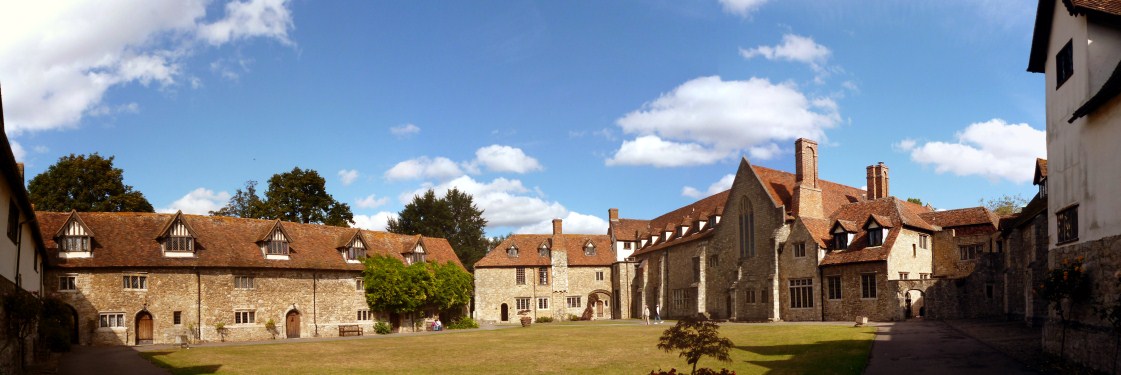
"The Friars" (Aylsford Priory)
This was the Esperanto Association of Britain's site from 2005 to 2018. You will find its current site at esperanto.org.uk.
Last year I was only at Aylesford for the Monday, and the year before a flying visit, but this year due to a change in family circumstances and because I am in full time work I could do both the Saturday and Sunday, staying overnight. So I arrived Saturday morning around 10:45, just in time for coffee and met Magdalina Georgieva from Bulgaria — well I suppose they don't call it the Internacia Amikeca Renkontiĝo (IAR) for nothing!

"The Friars" (Aylsford Priory)
The first talk I saw was from Bill Walker on the EAB Website. I had seen the website before, but this time Bill explained the reasons behind the structure of the website and which languages were used when, plus password protection giving EAB members access to latest edition of EAB Update. (I really must get around to asking for electronic only copy.) Magdalina's quiz was next, targeting my biggest weakness in Esperanto when to use the "-n" ending by use of a tongue twister. Terry Page then explained the planned walk in the afternoon by reference to the map and pictures from Google Earth showing the remains of a Roman Villa.
Before we set out, we all headed for lunch. The refectory in The Friary tends towards the traditional English meal of meat and two vegetables - and in this case a pudding with custard, my personal hate. After a short digestive pause we gathered for the walk - most of the people that were there participated, although Ken said he was off for a nap, which has a different meaning in Esperanto ["napo"= turnip] . Generally we managed to find our way successfully, although the path was rather overgrown and limited to one person-width to the area where the villa was supposed to be. After some discussion we couldn't see any villa at the designated spot. As a regular watcher of Time Team I thought the archaeologists had might have covered it over again. Terry asked a passing local walking his dog and he said yes, the villa was in the centre of the brown field we were standing next to and there was nothing to be seen. Clearly the Google Earth photos were out of date. I think from that moment, it seemed like a mad dash back to The Friary for the afternoon tea and cake.
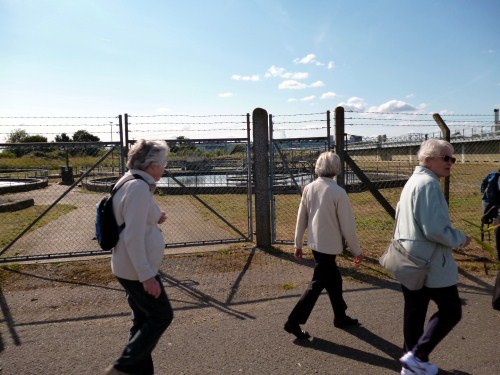
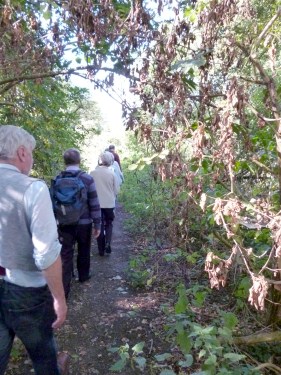
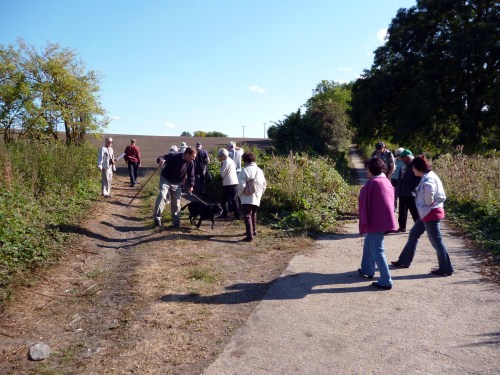
Past the sewage works and the solar power station, down an overgrown footpath, and into a field with a (buried) Roman villa.
After refreshments Mike Wade took us on a journey through Yugoslavia via the memoirs of a traveller from the 1950s and pictures from his own parents who had recreated that journey. I think it helped having Anica from Slovenia there to help bring the pictures to life. Roy Simmons then took on a guided tour of various enclaves throughout Europe including the enclave of Croatia in Slovenia, although Anica didn't know about that one.
Post dinner entertainment came from Kimie Markarian who demonstrated her kimonos with the help of willing volunteers including our own Bill Walker, Anica Page, Joyce Bunting and Wilfrid Jaques. Anica's kimono was by the far the most involved as Kimie wrapped several levels of ties round Anica. Kimie explained that in Japanese culture the decoration has switched from the front to the back. When you could see the material strip that the kimono was made up from, it became clearer how it was put together.
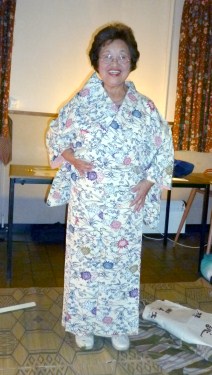
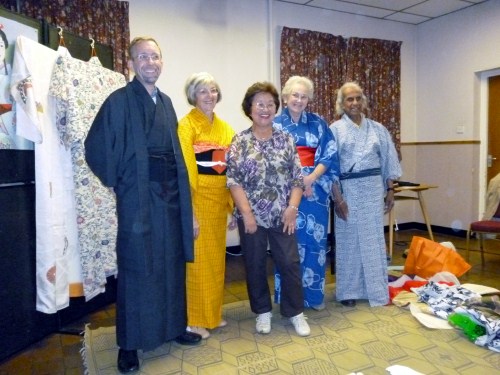
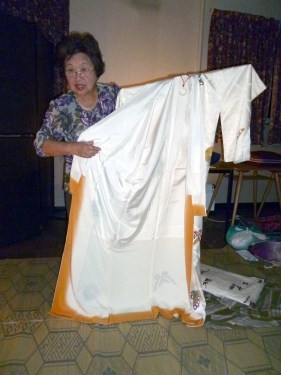
Kimie Markarian demonstrates the Kimono.
This was the first time I had stayed overnight at The Friars. The room looked ok, with a washbasin and [in my case] a toilet and shower shared with one other room. However when I lay down on the bed the mattress was uncomfortable and felt like the springs were worn out. In the morning I was woken to the sound of a small child being asked "are you still a monkey?" Clearly the sound carries in the older buildings.
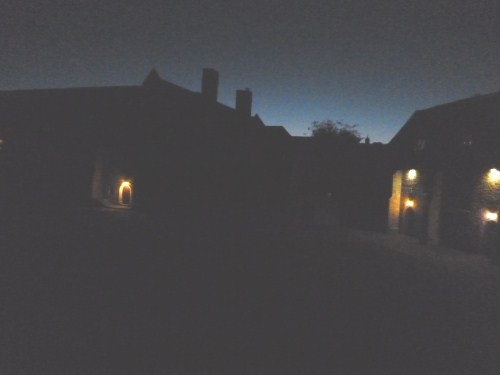


The priory at night; traditional accommodation; breakfast
Breakfast on Sunday morning was the usual choice but the seating arrangement confused us, as [following a banquet the previous evening the tables had been re-arranged and] there no longer was one table marked "Esperanto". After breakfast Andy Pepperdine gave a talk on the meaning of marriage, as the "theme" of the weekend was "families". I am single so couldn't talk much here. I think Terry's talk on heraldry was more my thing, as I had studied some of the shields previously. Joyce's quiz asked you to put various animals and plants into the right families — actually the most difficult thing here was not unfamiliar Esperanto words, but understanding the difference between an elk and a cow.
Possibly the most enjoyable part of the meeting was the game of "Lexicon" that Roy organised, after having personally created the five decks of cards. Sitting with Bill, Joyce and Roland I thought they would clearly walk all over me, as my Esperanto spelling isn't that good, as for me Esperanto is mainly a spoken language. However after winning the first two games, Bill was playing to minimise his losses although I was picking up some up tricks from him. I played an eight letter word in the next game, but Joyce had started to get the hang of Lexicon and went on to win the next three games straight.
Joyce talked on grasses, including the maize cutting that she had found in field on the walk the previous day. By the end of the talk there was grass and seeds everywhere on the table. Joyce did say that grasses were fertilized by the wind meaning they didn't need Ken Stevens' bees. Ken described the bee lifecycle including the creation of a new queen. Ken mentioned that spraying water on bees in more effective than smoke when pacifying them.
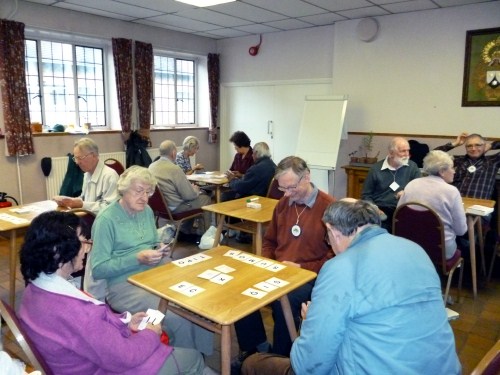
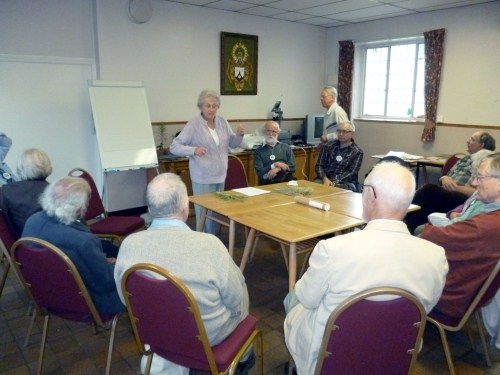
Roy Simmons' Leksikono game and Joyce Bunting's talk on grasses
Terry played us some Internet radio recordings from Cuba and Poland, including singing in Esperanto. A large part of the broadcast seemed to be thinly disguised tourist propaganda about the country.
After dinner it was time for me to drive home via Aylesford station. Thank you to Terry and Anica Page for organising the meeting and to all the speakers.
Kevin Murray
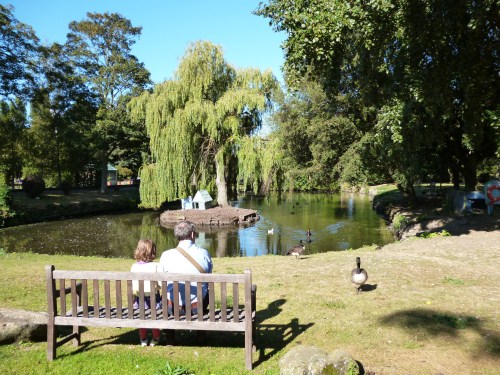
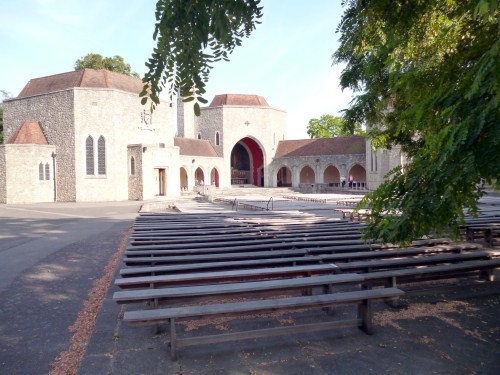
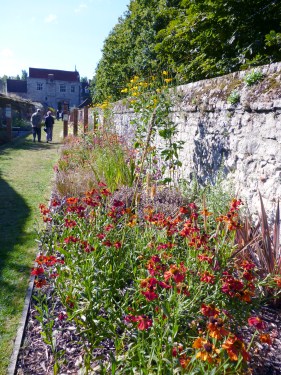
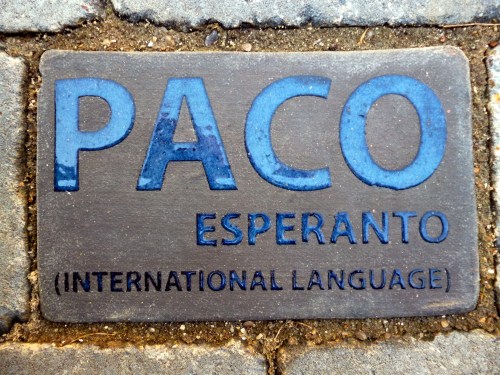
Aylsford Priory's grounds include a recently-established "Peace Garden" with tiles in many different languages. Esperantists attending the annual Internacia Amikeca Renkontiĝo meetings over the years have sponsored a tile saying "PACO" [Peace] in Esperanto.